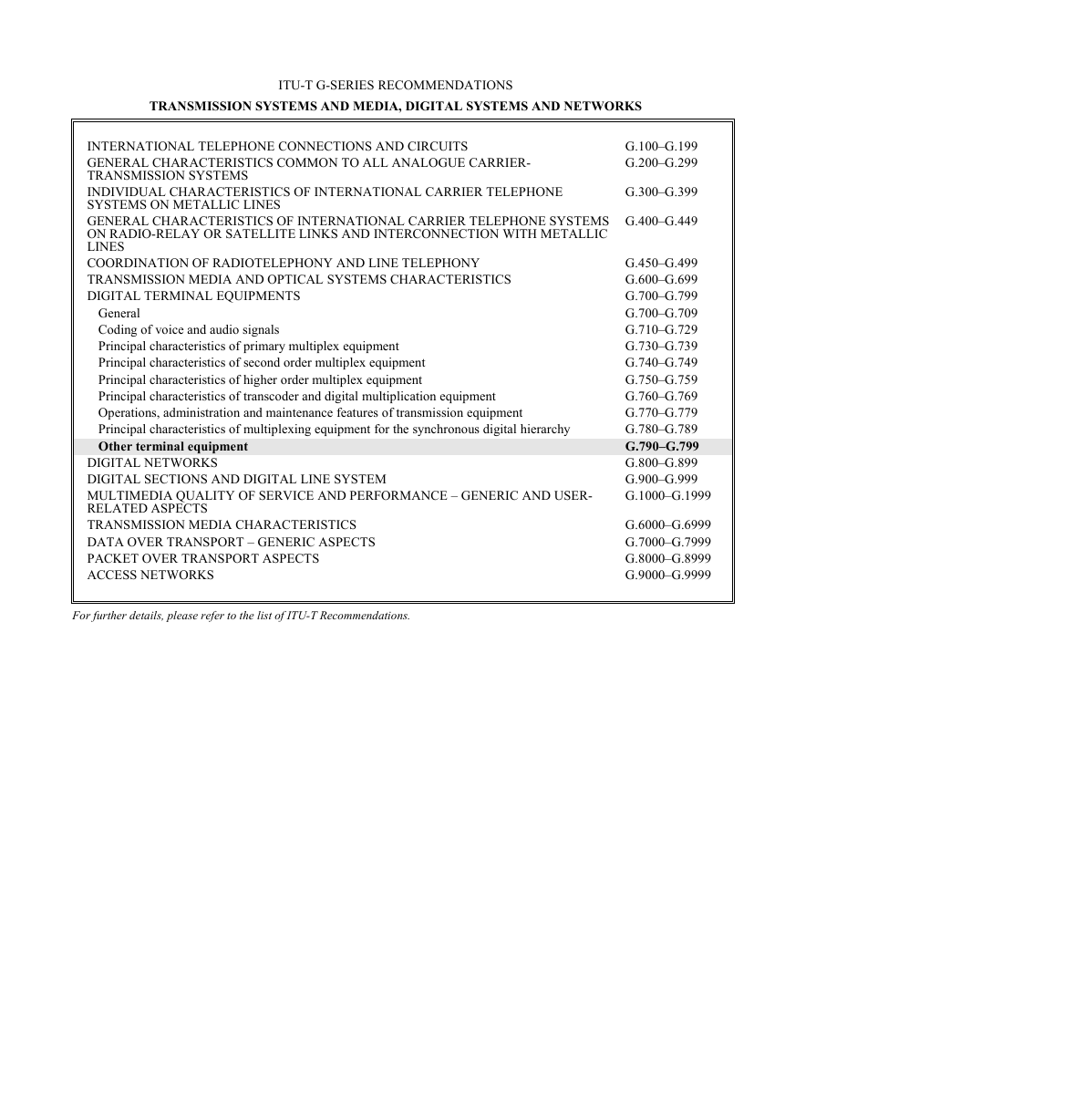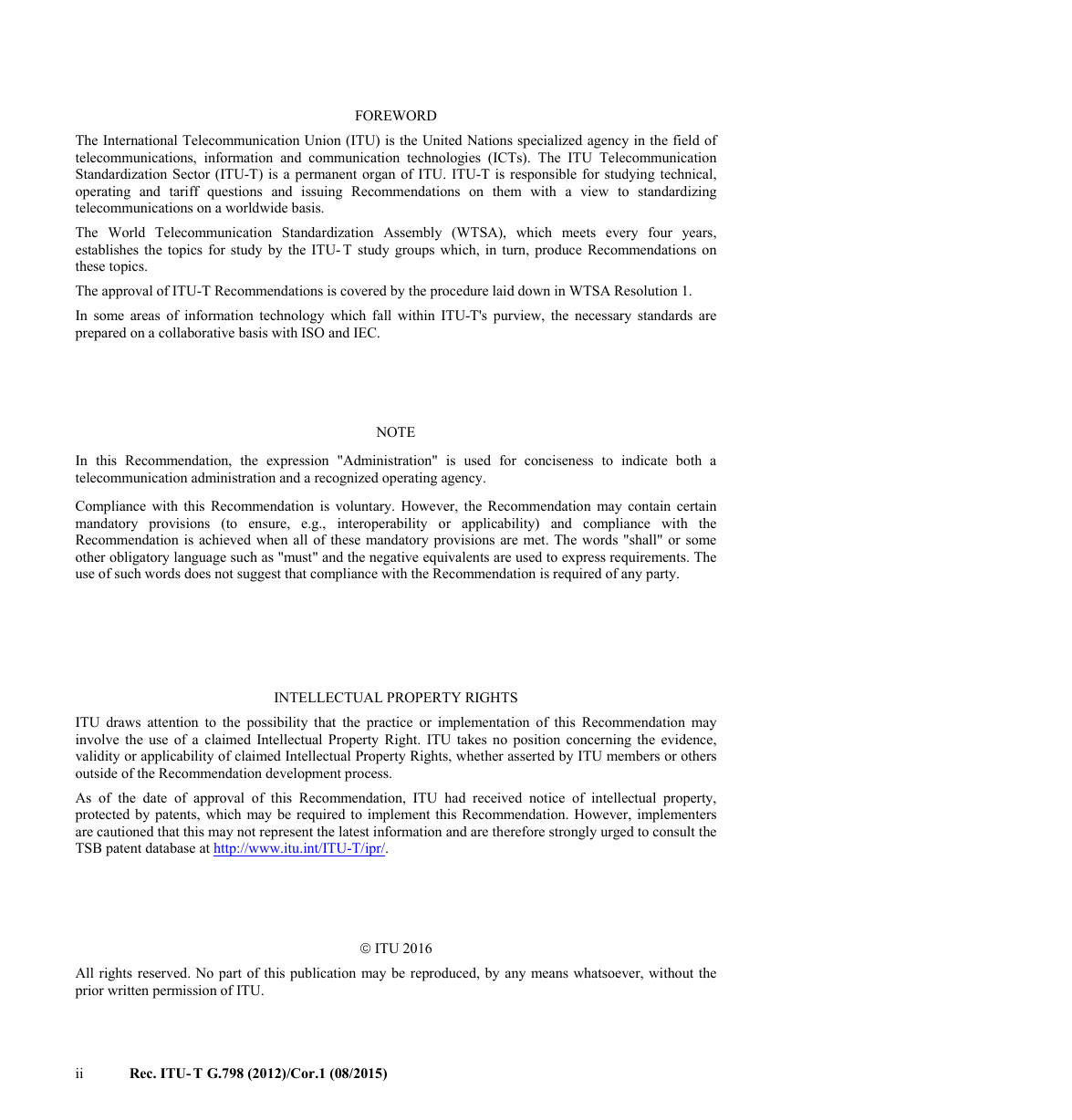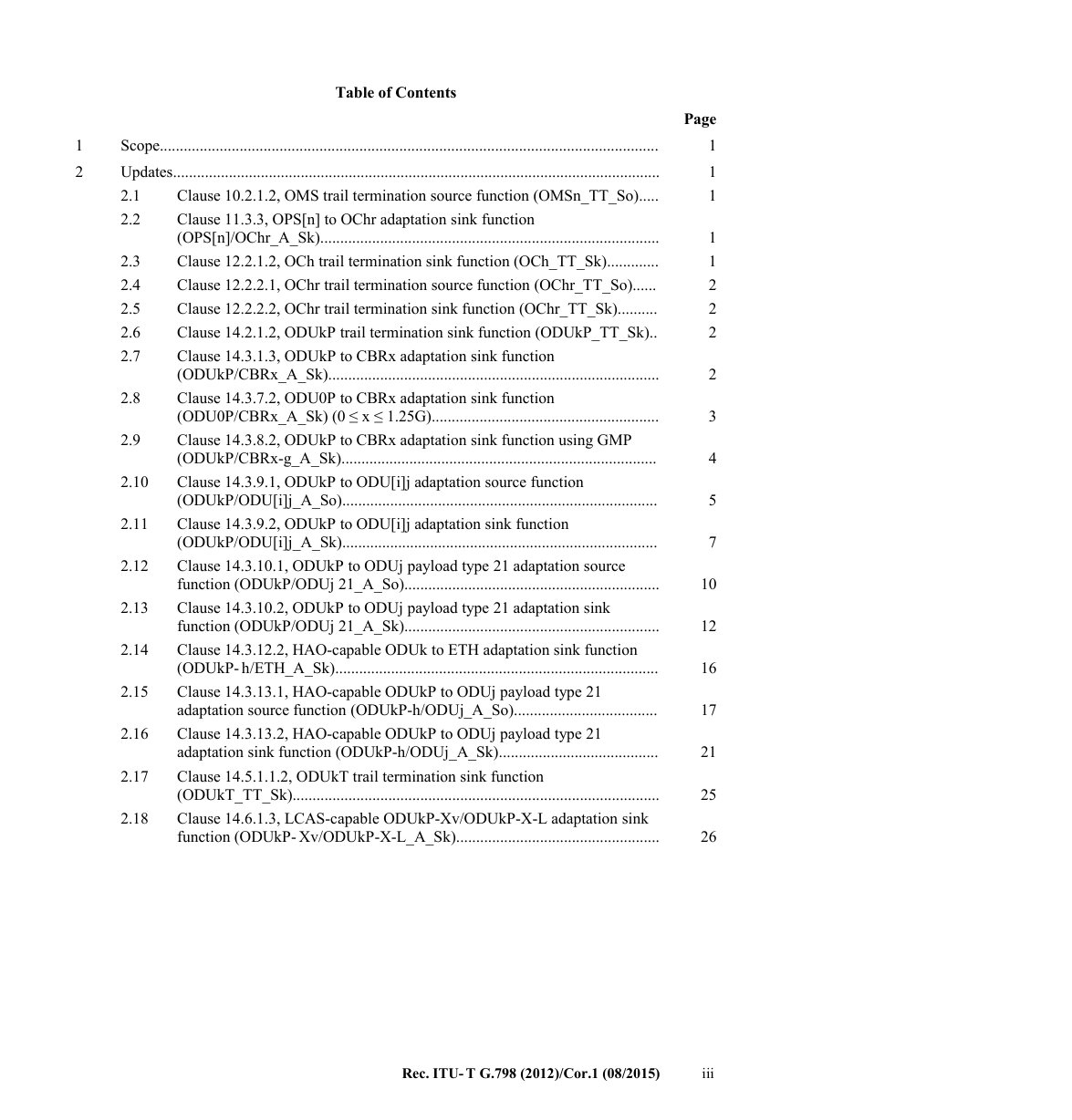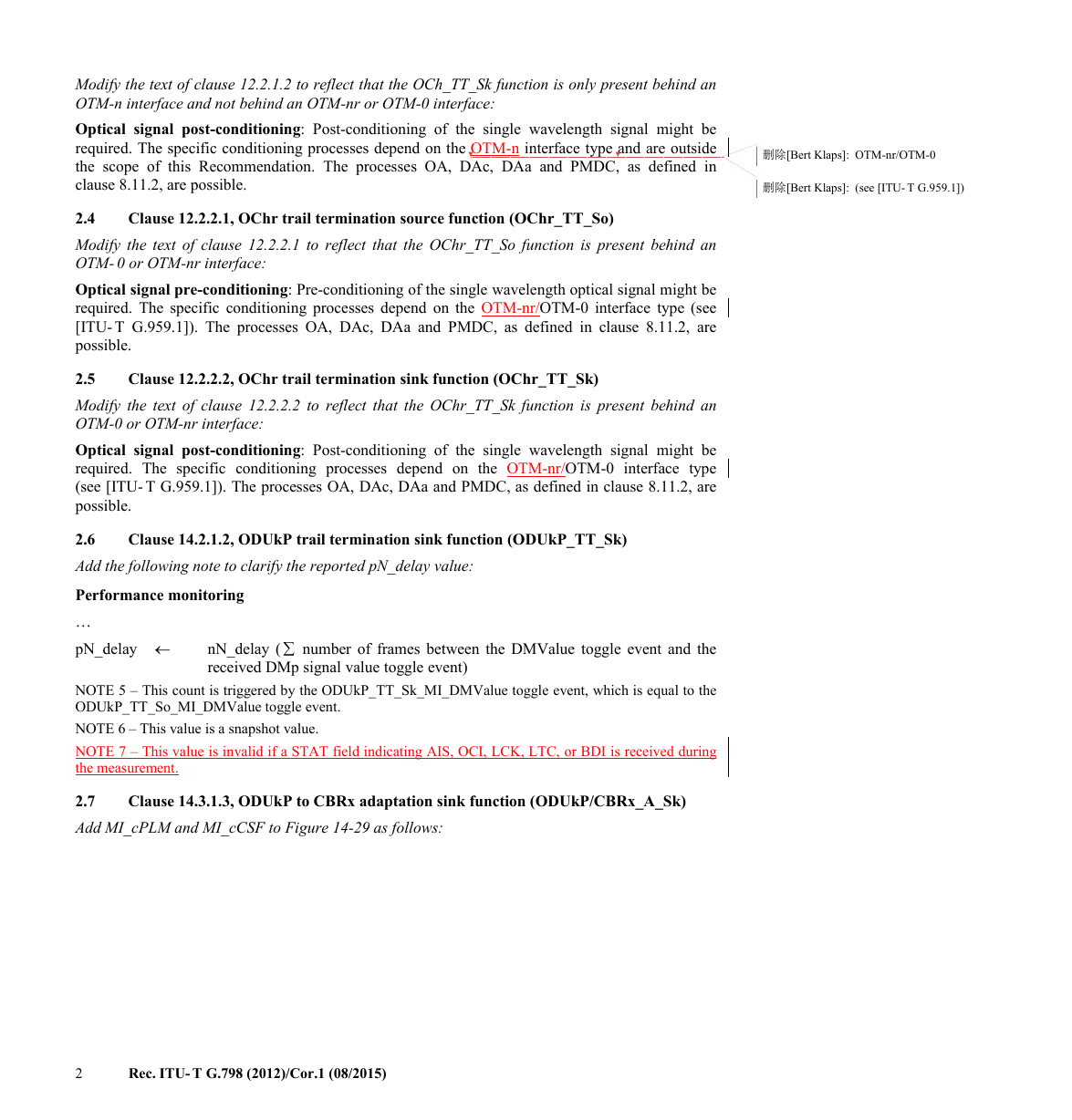I n t e r n a t i o n a l T e l e c o m m u n i c a t i o n U n i o n
ITU-T
TELECOMMUNICATION
STANDARDIZATION SECTOR
OF ITU
G.798
Corrigendum 1
(08/2015)
SERIES G: TRANSMISSION SYSTEMS AND MEDIA,
DIGITAL SYSTEMS AND NETWORKS
Digital terminal equipments – Other terminal equipment
Characteristics of optical transport network
hierarchy equipment functional blocks
Corrigendum 1
Recommendation ITU- T G.798 (2012) – Corrigendum 1
�
TRANSMISSION SYSTEMS AND MEDIA, DIGITAL SYSTEMS AND NETWORKS
ITU-T G-SERIES RECOMMENDATIONS
INTERNATIONAL TELEPHONE CONNECTIONS AND CIRCUITS
GENERAL CHARACTERISTICS COMMON TO ALL ANALOGUE CARRIER-
TRANSMISSION SYSTEMS
INDIVIDUAL CHARACTERISTICS OF INTERNATIONAL CARRIER TELEPHONE
SYSTEMS ON METALLIC LINES
GENERAL CHARACTERISTICS OF INTERNATIONAL CARRIER TELEPHONE SYSTEMS
ON RADIO-RELAY OR SATELLITE LINKS AND INTERCONNECTION WITH METALLIC
LINES
COORDINATION OF RADIOTELEPHONY AND LINE TELEPHONY
TRANSMISSION MEDIA AND OPTICAL SYSTEMS CHARACTERISTICS
DIGITAL TERMINAL EQUIPMENTS
General
Coding of voice and audio signals
Principal characteristics of primary multiplex equipment
Principal characteristics of second order multiplex equipment
Principal characteristics of higher order multiplex equipment
Principal characteristics of transcoder and digital multiplication equipment
Operations, administration and maintenance features of transmission equipment
Principal characteristics of multiplexing equipment for the synchronous digital hierarchy
Other terminal equipment
DIGITAL NETWORKS
DIGITAL SECTIONS AND DIGITAL LINE SYSTEM
MULTIMEDIA QUALITY OF SERVICE AND PERFORMANCE – GENERIC AND USER-
RELATED ASPECTS
TRANSMISSION MEDIA CHARACTERISTICS
DATA OVER TRANSPORT – GENERIC ASPECTS
PACKET OVER TRANSPORT ASPECTS
ACCESS NETWORKS
G.100–G.199
G.200–G.299
G.300–G.399
G.400–G.449
G.450–G.499
G.600–G.699
G.700–G.799
G.700–G.709
G.710–G.729
G.730–G.739
G.740–G.749
G.750–G.759
G.760–G.769
G.770–G.779
G.780–G.789
G.790–G.799
G.800–G.899
G.900–G.999
G.1000–G.1999
G.6000–G.6999
G.7000–G.7999
G.8000–G.8999
G.9000–G.9999
For further details, please refer to the list of ITU-T Recommendations.
�
Recommendation ITU-T G.798
Characteristics of optical transport network hierarchy equipment functional
blocks
Corrigendum 1
Summary
Corrigendum 1 to Recommendation ITU-T G.798 (2012) contains modifications correcting the
interface type for OCh and OChr trail termination functions, aligns the specification of management
interfaces in ODUkP adaptation functions and adds a clarification to the reported delay measurement
value in the presence of maintenance signals.
History
Edition
1.0
1.1
2.0
3.0
3.1
3.2
4.0
4.1
4.2
4.3
4.4
5.0
5.1
5.2
5.3
ITU-T G.798
ITU-T G.798
ITU-T G.798
ITU-T G.798
ITU-T G.798
Recommendation
Approval
2002-01-06
ITU-T G.798 (2002) Amd. 1 2002-06-13
2004-06-13
2006-12-14
ITU-T G.798 (2006) Amd. 1 2008-12-12
2009-01-13
ITU-T G.798 (2006) Cor.1
2010-10-22
ITU-T G.798 (2010) Cor. 1
2011-04-13
ITU-T G.798 (2010) Amd. 1 2011-07-22
ITU-T G.798 (2010) Cor. 2
2012-02-13
ITU-T G.798 (2010) Amd. 2 2012-04-06
2012-12-22
ITU-T G.798 (2012) Amd. 1 2014-05-14
ITU-T G.798 (2012) Amd. 2 2015-01-13
ITU-T G.798 (2012) Cor.1
2015-08-13
Study Group
Unique ID*
15
15
15
15
15
15
15
15
15
15
15
15
15
15
15
11.1002/1000/5604
11.1002/1000/6057
11.1002/1000/7329
11.1002/1000/8983
11.1002/1000/9669
11.1002/1000/9647
11.1002/1000/10877
11.1002/1000/11117
11.1002/1000/11116
11.1002/1000/11488
11.1002/1000/11487
11.1002/1000/11778
11.1002/1000/12179
11.1002/1000/12367
11.1002/1000/12529
* To access the Recommendation, type the URL http://handle.itu.int/ in the address field of your web
browser, followed by the Recommendation's unique ID. For example, http://handle.itu.int/11.1002/1000/11
830-en.
Rec. ITU- T G.798 (2012)/Cor.1 (08/2015)
i
�
FOREWORD
The International Telecommunication Union (ITU) is the United Nations specialized agency in the field of
telecommunications, information and communication technologies (ICTs). The ITU Telecommunication
Standardization Sector (ITU-T) is a permanent organ of ITU. ITU-T is responsible for studying technical,
operating and tariff questions and issuing Recommendations on them with a view to standardizing
telecommunications on a worldwide basis.
The World Telecommunication Standardization Assembly (WTSA), which meets every four years,
establishes the topics for study by the ITU- T study groups which, in turn, produce Recommendations on
these topics.
The approval of ITU-T Recommendations is covered by the procedure laid down in WTSA Resolution 1.
In some areas of information technology which fall within ITU-T's purview, the necessary standards are
prepared on a collaborative basis with ISO and IEC.
NOTE
the expression "Administration" is used for conciseness to indicate both a
In this Recommendation,
telecommunication administration and a recognized operating agency.
Compliance with this Recommendation is voluntary. However, the Recommendation may contain certain
mandatory provisions (to ensure, e.g.,
interoperability or applicability) and compliance with the
Recommendation is achieved when all of these mandatory provisions are met. The words "shall" or some
other obligatory language such as "must" and the negative equivalents are used to express requirements. The
use of such words does not suggest that compliance with the Recommendation is required of any party.
INTELLECTUAL PROPERTY RIGHTS
ITU draws attention to the possibility that the practice or implementation of this Recommendation may
involve the use of a claimed Intellectual Property Right. ITU takes no position concerning the evidence,
validity or applicability of claimed Intellectual Property Rights, whether asserted by ITU members or others
outside of the Recommendation development process.
As of the date of approval of this Recommendation, ITU had received notice of intellectual property,
protected by patents, which may be required to implement this Recommendation. However, implementers
are cautioned that this may not represent the latest information and are therefore strongly urged to consult the
TSB patent database at http://www.itu.int/ITU-T/ipr/.
All rights reserved. No part of this publication may be reproduced, by any means whatsoever, without the
prior written permission of ITU.
ITU 2016
ii
Rec. ITU- T G.798 (2012)/Cor.1 (08/2015)
�
1
2
Table of Contents
2.8
2.9
2.10
2.3
2.4
2.5
2.6
2.7
Scope.............................................................................................................................
Updates..........................................................................................................................
Clause 10.2.1.2, OMS trail termination source function (OMSn_TT_So).....
2.1
Clause 11.3.3, OPS[n] to OChr adaptation sink function
2.2
(OPS[n]/OChr_A_Sk).....................................................................................
Clause 12.2.1.2, OCh trail termination sink function (OCh_TT_Sk).............
Clause 12.2.2.1, OChr trail termination source function (OChr_TT_So)......
Clause 12.2.2.2, OChr trail termination sink function (OChr_TT_Sk)..........
Clause 14.2.1.2, ODUkP trail termination sink function (ODUkP_TT_Sk)..
Clause 14.3.1.3, ODUkP to CBRx adaptation sink function
(ODUkP/CBRx_A_Sk)...................................................................................
Clause 14.3.7.2, ODU0P to CBRx adaptation sink function
(ODU0P/CBRx_A_Sk) (0 ≤ x ≤ 1.25G).........................................................
Clause 14.3.8.2, ODUkP to CBRx adaptation sink function using GMP
(ODUkP/CBRx-g_A_Sk)...............................................................................
Clause 14.3.9.1, ODUkP to ODU[i]j adaptation source function
(ODUkP/ODU[i]j_A_So)...............................................................................
Clause 14.3.9.2, ODUkP to ODU[i]j adaptation sink function
(ODUkP/ODU[i]j_A_Sk)...............................................................................
Clause 14.3.10.1, ODUkP to ODUj payload type 21 adaptation source
function (ODUkP/ODUj 21_A_So)................................................................
Clause 14.3.10.2, ODUkP to ODUj payload type 21 adaptation sink
function (ODUkP/ODUj 21_A_Sk)................................................................
Clause 14.3.12.2, HAO-capable ODUk to ETH adaptation sink function
(ODUkP- h/ETH_A_Sk).................................................................................
Clause 14.3.13.1, HAO-capable ODUkP to ODUj payload type 21
adaptation source function (ODUkP-h/ODUj_A_So)....................................
Clause 14.3.13.2, HAO-capable ODUkP to ODUj payload type 21
adaptation sink function (ODUkP-h/ODUj_A_Sk)........................................
Clause 14.5.1.1.2, ODUkT trail termination sink function
(ODUkT_TT_Sk)............................................................................................
Clause 14.6.1.3, LCAS-capable ODUkP-Xv/ODUkP-X-L adaptation sink
function (ODUkP- Xv/ODUkP-X-L_A_Sk)...................................................
2.15
2.16
2.14
2.11
2.12
2.13
2.17
2.18
Page
1
1
1
1
1
2
2
2
2
3
4
5
7
10
12
16
17
21
25
26
Rec. ITU- T G.798 (2012)/Cor.1 (08/2015)
iii
�
�
Recommendation ITU-T G.798
Characteristics of optical transport network hierarchy equipment functional
blocks
Corrigendum 1
Scope
1
Corrigendum 1 contains modifications correcting the interface type for OCh and OChr trail
termination functions, aligns the specification of management interfaces in ODUkP adaptation
functions and adds a clarification to the reported delay measurement value in the presence of
maintenance signals.
2
Updates
Clause 10.2.1.2, OMS trail termination source function (OMSn_TT_So)
2.1
Update Figure 10-6 in clause 10.2.1.2 as follows:
Figure 10-6 – OMSn_TT_So processes
Clause 11.3.3, OPS[n] to OChr adaptation sink function (OPS[n]/OChr_A_Sk)
2.2
Correct consequent actions specification as follows:
Consequent actions
The OPS[n]/OChr_A_Sk function for [n= 16, 32] performs the following consequent actions.
aSSF-P[1..n] AI_TSF-P
2.3
Clause 12.2.1.2, OCh trail termination sink function (OCh_TT_Sk)
Rec. ITU- T G.798 (2012)/Cor.1 (08/2015)
1
OMSn_AP
AI_PLD
AI_OH
dLOS-P
aPMI
Insert PMI
Insert BDI-P
Insert BDI-O
n
o
i
t
r
e
s
n
i
H
O
S
M
O
OOS
CI_PLD
CI_PLD
OMSn_TCP
删除[Bert Klaps]:
删除[Bert Klaps]:
[1..[n]]
G.798(10)_F10-6
�
删除[Bert Klaps]:
OTM-nr/OTM-0
删除[Bert Klaps]:
(see [ITU- T G.959.1])
Modify the text of clause 12.2.1.2 to reflect that the OCh_TT_Sk function is only present behind an
OTM-n interface and not behind an OTM-nr or OTM-0 interface:
Optical signal post-conditioning: Post-conditioning of the single wavelength signal might be
required. The specific conditioning processes depend on the OTM-n interface type and are outside
the scope of this Recommendation. The processes OA, DAc, DAa and PMDC, as defined in
clause 8.11.2, are possible.
Clause 12.2.2.1, OChr trail termination source function (OChr_TT_So)
2.4
Modify the text of clause 12.2.2.1 to reflect that the OChr_TT_So function is present behind an
OTM- 0 or OTM-nr interface:
Optical signal pre-conditioning: Pre-conditioning of the single wavelength optical signal might be
required. The specific conditioning processes depend on the OTM-nr/OTM-0 interface type (see
[ITU- T G.959.1]). The processes OA, DAc, DAa and PMDC, as defined in clause 8.11.2, are
possible.
Clause 12.2.2.2, OChr trail termination sink function (OChr_TT_Sk)
2.5
Modify the text of clause 12.2.2.2 to reflect that the OChr_TT_Sk function is present behind an
OTM-0 or OTM-nr interface:
Optical signal post-conditioning: Post-conditioning of the single wavelength signal might be
required. The specific conditioning processes depend on the OTM-nr/OTM-0 interface type
(see [ITU- T G.959.1]). The processes OA, DAc, DAa and PMDC, as defined in clause 8.11.2, are
possible.
Clause 14.2.1.2, ODUkP trail termination sink function (ODUkP_TT_Sk)
2.6
Add the following note to clarify the reported pN_delay value:
Performance monitoring
…
pN_delay
nN_delay ( number of frames between the DMValue toggle event and the
received DMp signal value toggle event)
NOTE 5 – This count is triggered by the ODUkP_TT_Sk_MI_DMValue toggle event, which is equal to the
ODUkP_TT_So_MI_DMValue toggle event.
NOTE 6 – This value is a snapshot value.
NOTE 7 – This value is invalid if a STAT field indicating AIS, OCI, LCK, LTC, or BDI is received during
the measurement.
Clause 14.3.1.3, ODUkP to CBRx adaptation sink function (ODUkP/CBRx_A_Sk)
2.7
Add MI_cPLM and MI_cCSF to Figure 14-29 as follows:
2
Rec. ITU- T G.798 (2012)/Cor.1 (08/2015)
�
















 2023年江西萍乡中考道德与法治真题及答案.doc
2023年江西萍乡中考道德与法治真题及答案.doc 2012年重庆南川中考生物真题及答案.doc
2012年重庆南川中考生物真题及答案.doc 2013年江西师范大学地理学综合及文艺理论基础考研真题.doc
2013年江西师范大学地理学综合及文艺理论基础考研真题.doc 2020年四川甘孜小升初语文真题及答案I卷.doc
2020年四川甘孜小升初语文真题及答案I卷.doc 2020年注册岩土工程师专业基础考试真题及答案.doc
2020年注册岩土工程师专业基础考试真题及答案.doc 2023-2024学年福建省厦门市九年级上学期数学月考试题及答案.doc
2023-2024学年福建省厦门市九年级上学期数学月考试题及答案.doc 2021-2022学年辽宁省沈阳市大东区九年级上学期语文期末试题及答案.doc
2021-2022学年辽宁省沈阳市大东区九年级上学期语文期末试题及答案.doc 2022-2023学年北京东城区初三第一学期物理期末试卷及答案.doc
2022-2023学年北京东城区初三第一学期物理期末试卷及答案.doc 2018上半年江西教师资格初中地理学科知识与教学能力真题及答案.doc
2018上半年江西教师资格初中地理学科知识与教学能力真题及答案.doc 2012年河北国家公务员申论考试真题及答案-省级.doc
2012年河北国家公务员申论考试真题及答案-省级.doc 2020-2021学年江苏省扬州市江都区邵樊片九年级上学期数学第一次质量检测试题及答案.doc
2020-2021学年江苏省扬州市江都区邵樊片九年级上学期数学第一次质量检测试题及答案.doc 2022下半年黑龙江教师资格证中学综合素质真题及答案.doc
2022下半年黑龙江教师资格证中学综合素质真题及答案.doc